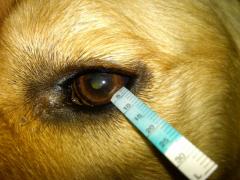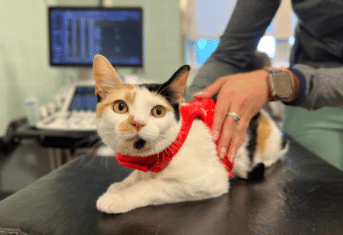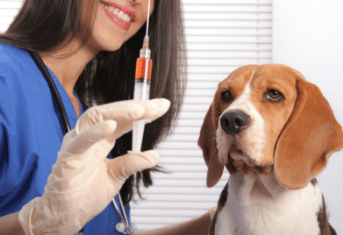Research at The AMC Demonstrates There are Fewer Tears in ICU

Research at The AMC Demonstrates There are Fewer Tears in ICU
Medicine is a discipline full of questions. Clients want to know how their pet got a disease and medical professionals want to know how best to fix the disease. Many of these questions can best be answered using real patients with spontaneously occurring medical conditions. This type of research, called clinical research, is the type performed at The Animal Medical Center. In our day to day practice we have hundreds of questions on how better to care for our patients, and some of these questions ultimately form the basis for the research performed and published by AMC veterinarians. Here is a summary of one such study.
Measuring Tears
Veterinarians have a very simple method for measuring tears, the Schirmer tear test which is shown in the photo. This test uses a special type of ruler paper that turns Blue as it absorbs the tears. Normal eyes produce about 15-25mm of tears per minute, as indicated by the blue color on the strip pictured. A decrease in normal tear production is called ‘dry eye’ and predisposes dogs and cats to developing corneal problems, such as painful corneal ulcers.
Causes of Dry Eye
Medications, general anesthesia, infections and immune disorders can decrease tear production. Dogs and cats in any intensive care unit, The AMC’s included, are the most seriously ill patients in the hospital and are the patients with a myriad of problems. Intensive care patients also receive many drugs and often need general anesthesia to correct their problems. Because The AMC’s ICU and ophthalmology veterinarians recognized the potential for tear production to be decreased in ICU patients. They also recognized decreased tear production would add to these patients long list of problems. Acting on those concerns for their patients, these veterinarians teamed up to study the tear production in canine ICU patients.
Fewer Tears in ICU
The study’s hypothesis was tear production in canine ICU patients would be decreased, compared to a group of normal dogs. Thirty normal and 30 dogs in ICU were studied, and true to the hypotheses, dogs in ICU had significantly decreased tear production as measured by the Schirmer tear test. This finding is important for dogs in ICU’s everywhere because the study’s conclusion was to recommend ocular lubricants be considered in all dogs hospitalized in ICU to prevent the consequences of dry eye. Although not every dog was re-examined, two dogs were and both regained normal tear production after hospital discharge, suggesting the decrease in tear production in ICU patients is not always permanent.
You and Your Pet Can Help
Clinical research like this happens every day at veterinary hospitals. If your veterinarian suggests you and your pet participate in a clinical trial, seriously consider it. Your pet will receive top-notch care as a participant and will help advance medical care benefitting other pets as well.

































